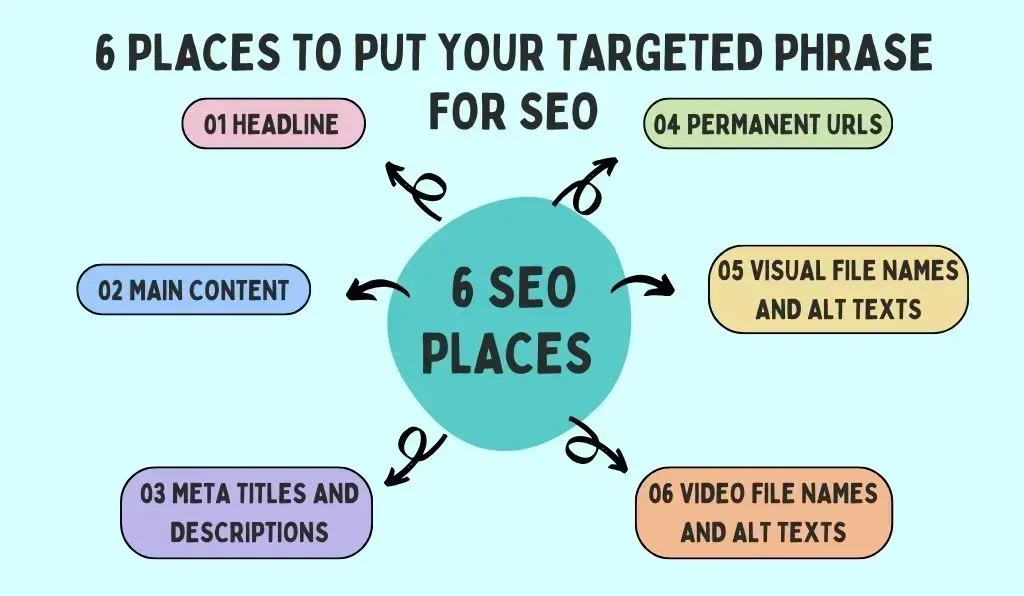The 6 Places to Put Your Targeted Phrase or Keyword for SEO

One fundamental aspect of Search Engine Optimization (SEO) is targeting specific search terms or phrases, commonly known as keywords. However, it's not just about choosing the right keywords; it's also about strategically placing them on your webpage. In this article, we will explore the six crucial places to put your targeted phrase or keyword for optimal SEO results.
1. Craft an SEO-Optimized Headline (H1)
The headline, or H1 tag, is arguably the most critical place to position your target phrase or keyword. When crafting your headline, aim for precision and clarity. Keep it concise, ideally between 60-80 characters, and place your targeted phrase towards the beginning. Google often uses the title displayed in the search results, making it a vital element for attracting clicks. Your headline should provide a clear indication of your page's content.
2. Optimize Your Webpage's Main Content
The content of your webpage plays a pivotal role in SEO. To maximize its impact, it's advisable to position your targeted phrase near the beginning of your content. This ensures that users quickly identify the relevance of your page to their search. Unlike some SEO tools might suggest, there's no need to obsess over a specific keyword density based on word count. Instead, focus on ensuring that your main content naturally aligns with your targeted phrase.
3. Create Irresistible SEO Titles and Descriptions
Your SEO title and description (also known as Meta title and descriptions) are the first things users see in search results. To make the most of this opportunity, place your targeted phrase at the beginning of the SEO title. While it's not mandatory for the description, doing so can enhance click-through rates (I still recommend to place it once in there). Additionally, consider using numbers and visual elements to make your listing more appealing and informative.
4. Use permanent URLs including the Targeted Term
The URL of your webpage is another strategic location for your targeted phrase. However, it's essential to remember that the permanence of your URL is even more crucial. Changing your URL can result in the loss of organic traffic unless you set up proper redirects for the old URL. Therefore, focus on creating a URL that accurately represents your content and keyword that lasts for a long time.
5. Visual SEO: Use the File Names and Alt Texts of the Main Images
Images on your webpage provide an opportunity for SEO optimization as well. Both the image file name and alt text should contain your targeted phrase. Google relies on this information because it cannot fully comprehend the content of images (yet). This is especially significant for the main or first image on your page. Including alt text for all other images can also enhance the overall SEO quality of your webpage.
6. Video SEO: Again Use the File Name and Description
If your webpage includes videos, don't overlook the video file name and description as key places to insert your targeted phrase. This is especially crucial if the video is the primary content of your page. Ensuring that your video elements align with your SEO strategy can boost your page's visibility in search results.
In conclusion, SEO success hinges on both keyword selection and placement. While the quantity of keyword usage may not be as important as you think, the strategic placement of your targeted phrase across these six critical locations can significantly impact your search engine rankings. Remember, SEO is not just about pleasing search engines; it's about delivering valuable content that aligns with what users are searching for.
Is keyword stuffing a good SEO practice?
Keyword stuffing, the practice of excessively using keywords, is not a good SEO strategy. Search engines rather penalize websites that engage in keyword stuffing, if it results in poor user experience. Focus on natural and relevant keyword placement instead.
How can I ensure my SEO title and description stand out in search results?
To make your SEO title and description stand out, place your targeted phrase at the beginning, use numbers, and incorporate visual elements when possible. This can attract more clicks from users.
Do I need to include the targeted phrase in every image on my webpage?
It's not necessary to include the targeted phrase in every image. Focus on the main or first image and provide alt text for all other images to enhance your webpage's SEO.
What should I do if I need to change my webpage's URL?
If you need to change your webpage's URL, ensure you set up proper redirects from the old URL to the new one. This helps retain the organic traffic you had on the previous URL.
Is video SEO important for my webpage?
Video SEO is essential if you have videos on your webpage, particularly if they are a significant part of your content. Optimizing video file names and descriptions can improve your page's search engine visibility.

